

Restorative Justice and Community Conferencing Lauren Abramson, Ph.D. Community Conferencing Center Baltimore, MD www.CommunityConferencing.org
We CAN do better. Justice as healing, learning & accountability
Addressing Common Needs Expressed by Stakeholders • Provide meaningful response to juvenile crime • Address DMC issues • Give victims a voice • Better outcomes – socially and fiscally • Address root causes
Traditional Justice Restorative Justice (Retributive) The process is characterized by The process is characterized by dialogue and negotiation among adversarial relationships managed by participants professionals (lawyers, judges, etc.) Victims are central to the process Victims are peripheral to the process Focus is on repairing the harm (to Focus on punishing the offender relationships, physical, monetary, etc ), healing and learning Victims and community are Victims and community are part of represented by the state deciding outcomes for themselves
Restorative Practices offer simple yet powerful structures for people to manage relationships and conflict in healthy ways by allowing people to be human (emotional)
Foundational Principles of RJ • There are no disposable people • Respect • Fairness • Inclusion • Expert Culture: Leaves large stores of untapped wisdom • Allow people to make decisions for themselves • Honor our biology as human beings • Allow for emotion • Value connection • Space to tell our story
RJ gives us leverage in addressing racial bias and disparities We need to use it more .
Dept. of Education, Office of Civil Rights Study of all 97,000 public schools (2014) • “…pattern of inequality on a number of fronts, with race as the dividing factor.” • African American students suspended/expelled at 3x the rate of white students • African American children make up 18% of preschool enrollment, but nearly 50% of preschool suspensions
The push back • Too soft on crime. It let’s kids off the hook. • “Too touchy feely” • What if they re-offend? • Principals don’t want to bring together any more than 2 people at a time. It get’s too crazy.
Community Conferencing
What happened?
How have people been affected?
What can be done to repair the harm prevent it from happening again
video
Referral Sources
Where we use it Anywhere there are people who are in conflict… for whatever reason • Criminal Justice Court diversion, case planning following detention • Schools Alternative to school suspension and arrest (bullying, fights, hate crimes) • Neighborhoods Ongoing, intractable conflicts • Workplaces Conflict, risk management, harassment, etc. • Human Services Collaborative and inclusive case / tx planning • Planning • Re-integration (following military service, incarceration, etc.) Collectively understand impact; reconnect with network of support
Kinds of Cases
19,000 Baltimore residents safely resolved their own crimes/conflicts using Community Conferencing
95% result in effective Agreements
60% less re-offending
1/10 th the cost of court
This is not just for first time offenders!
Felony Diversion After 1 year Half as likely to re-offend
Felony Diversion After 2 years One-third as likely to re-offend
96% Youth diverted in Baltimore are African-American
RJ gives us leverage in addressing racial bias and disparities We need to use it more.
video
The push back • Too soft on crime. It let’s kids off the hook. • “Too touchy feely” • What if they re-offend? • Principals don’t want to bring together any more than 2 people at a time. It get’s too crazy.
Recommend
More recommend